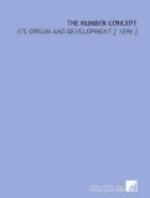The word for 40 was adopted because cowrie shells, which are used for counting, were strung by forties; and igba, 200, because a heap of 200 shells was five strings, and thus formed a convenient higher unit for reckoning. Proceeding in this curious manner,[106] they called 50 strings 1 afo or head; and to illustrate their singular mode of reckoning—the king of the Dahomans, having made war on the Yorubans, and attacked their army, was repulsed and defeated with a loss of “two heads, twenty strings, and twenty cowries” of men, or 4820.
The number scale of the Abipones,[107] one of the low tribes of the Paraguay region, contains two genuine curiosities, and by reason of those it deserves a place among any collection of numeral scales designed to exhibit the formation of this class of words. It is:
1. initara = 1 alone.
2. inoaka.
3. inoaka yekaini = 2 and 1.
4. geyenknate = toes of an
ostrich.
5. neenhalek = a five coloured,
spotted hide,
or
hanambegen = fingers of 1 hand.
10. lanamrihegem = fingers of both
hands.
20. lanamrihegem cat gracherhaka anamichirihegem
= fingers of both
hands together
with toes of both feet.
That the number sense of the Abipones is but little, if at all, above that of the native Australian tribes, is shown by their expressing 3 by the combination 2 and 1. This limitation, as we have already seen, is shared by the Botocudos, the Chiquitos, and many of the other native races of South America. But the Abipones, in seeking for words with which to enable themselves to pass beyond the limit 3, invented the singular terms just given for 4 and 5. The ostrich, having three toes in front and one behind on each foot presented them with a living example of 3 + 1; hence “toes of an ostrich” became their numeral for 4. Similarly, the number of colours in a certain hide being five, the name for that hide was adopted as their next numeral. At this point they began to resort to digital numeration also; and any higher number is expressed by that method.
In the sense in which the word is defined by mathematicians, number is a pure, abstract concept. But a moment’s reflection will show that, as it originates among savage races, number is, and from the limitations of their intellect must be, entirely concrete. An abstract conception is something quite foreign to the essentially primitive mind, as missionaries and explorers have found to their chagrin. The savage can form no mental concept of what civilized man means by such a word as “soul”; nor would his idea of the abstract number 5 be much clearer. When he says five, he uses, in many cases at least, the same word that serves him when he wishes to say hand; and his mental concept when he says five is of a hand. The concrete idea of a closed fist or an open hand with outstretched fingers, is what is upper-most in his mind. He




